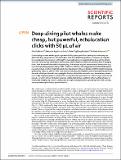Files in this item
Deep-diving pilot whales make cheap, but powerful, echolocation clicks with 50 µL of air
Item metadata
| dc.contributor.author | Foskolos, Ilias | |
| dc.contributor.author | Aguilar de Soto, Natacha | |
| dc.contributor.author | Madsen, Peter Teglberg | |
| dc.contributor.author | Johnson, Mark | |
| dc.date.accessioned | 2019-11-01T11:30:04Z | |
| dc.date.available | 2019-11-01T11:30:04Z | |
| dc.date.issued | 2019-10-31 | |
| dc.identifier | 262624813 | |
| dc.identifier | c360da9d-9b81-420a-9755-2c1395a0c213 | |
| dc.identifier | 85074267116 | |
| dc.identifier | 000493439600018 | |
| dc.identifier.citation | Foskolos , I , Aguilar de Soto , N , Madsen , P T & Johnson , M 2019 , ' Deep-diving pilot whales make cheap, but powerful, echolocation clicks with 50 µL of air ' , Scientific Reports , vol. 9 , 15720 . https://doi.org/10.1038/s41598-019-51619-6 | en |
| dc.identifier.issn | 2045-2322 | |
| dc.identifier.other | RIS: urn:A6E2DB9D1390CF593344A682EBB75A2A | |
| dc.identifier.other | RIS: Foskolos2019 | |
| dc.identifier.uri | https://hdl.handle.net/10023/18821 | |
| dc.description | Funding: Fieldwork was supported by the Strategic Environmental Research Development Program (US Govt.). Analyses were aided by a Marie Curie-Sklowdowska Career Integration Grant and an Aarhus University Visiting Professorship to M.J. N.A.S was supported by a Ramón y Cajal post-doctoral fellowship. I.F was supported by the Bodossaki Foundation and the A.G. Leventis Foundation. P.T.M was funded by a large frame grant from the Danish research council. | en |
| dc.description.abstract | Echolocating toothed whales produce powerful clicks pneumatically to detect prey in the deep sea where this long-range sensory channel makes them formidable top predators. However, air supplies for sound production compress with depth following Boyle’s law suggesting that deep-diving whales must use very small air volumes per echolocation click to facilitate continuous sensory flow in foraging dives. Here we test this hypothesis by analysing click-induced acoustic resonances in the nasal air sacs, recorded by biologging tags. Using 27000 clicks from 102 dives of 23 tagged pilot whales (Globicephala macrorhynchus), we show that click production requires only 50 µL of air/click at 500 m depth increasing gradually to 100 µL at 1000 m. With such small air volumes, the metabolic cost of sound production is on the order of 40 J per dive which is a negligible fraction of the field metabolic rate. Nonetheless, whales must make frequent pauses in echolocation to recycle air between nasal sacs. Thus, frugal use of air and periodic recycling of very limited air volumes enable pilot whales, and likely other toothed whales, to echolocate cheaply and almost continuously throughout foraging dives, providing them with a strong sensory advantage in diverse aquatic habitats. | |
| dc.format.extent | 9 | |
| dc.format.extent | 1591105 | |
| dc.language.iso | eng | |
| dc.relation.ispartof | Scientific Reports | en |
| dc.subject | QH301 Biology | en |
| dc.subject | DAS | en |
| dc.subject.lcc | QH301 | en |
| dc.title | Deep-diving pilot whales make cheap, but powerful, echolocation clicks with 50 µL of air | en |
| dc.type | Journal article | en |
| dc.contributor.institution | University of St Andrews. School of Biology | en |
| dc.contributor.institution | University of St Andrews. Scottish Oceans Institute | en |
| dc.contributor.institution | University of St Andrews. Sea Mammal Research Unit | en |
| dc.contributor.institution | University of St Andrews. Sound Tags Group | en |
| dc.contributor.institution | University of St Andrews. Bioacoustics group | en |
| dc.contributor.institution | University of St Andrews. Marine Alliance for Science & Technology Scotland | en |
| dc.identifier.doi | 10.1038/s41598-019-51619-6 | |
| dc.description.status | Peer reviewed | en |
This item appears in the following Collection(s)
Items in the St Andrews Research Repository are protected by copyright, with all rights reserved, unless otherwise indicated.

